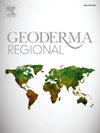Environmental magnetism linked to weathering processes: A study on surface soils from an East Antarctic oasis
IF 3.3
2区 农林科学
Q2 SOIL SCIENCE
引用次数: 0
Abstract
We determined and discussed the mineral magnetic properties of the soil samples (n = 78) from the Schirmacher Oasis, East Antarctica. Environmental magnetism analysis was conducted to identify the mechanisms controlling the formation and distribution of iron oxide minerals such as magnetite and hematite. Magnetic susceptibility (χlf) exhibited a mean (± SD) value of 109.5 (± 76.6) × 10−8 m3kg−1, indicating the presence of magnetically strong minerals. A statistically significant correlation (r = 0.79; p < 0.01) between χlf and saturation isothermal remanent magnetization (SIRM), the S-ratio values (0.97–0.99) and temperature-dependent magnetization measurements, suggests that low-coercivity magnetic minerals, such as magnetite, primarily regulate the magnetic signal. The percentage of frequency-dependent susceptibility remains below 2 % for most samples, indicating an insignificant presence of ultrafine superparamagnetic grains. The χARM/SIRM parameter (mean (± SD) values of 53.7 (± 26.3) × 10−5 mA−1) suggests a predominance of coarse-grained magnetic minerals, while magnetic hysteresis parameters indicate the dominance of multidomain magnetic grains, with minor proportions of single-domain and superparamagnetic grains. Various inter-parametric ratios reveal the absence of bacterial magnetite, anthropogenic magnetite, and authigenic greigite, suggesting that the magnetic minerals in these Antarctic soils from Schirmacher Oasis predominantly result from weathering processes.
与风化过程有关的环境磁力:对南极东部绿洲表层土壤的研究
我们测定并讨论了东南极洲Schirmacher绿洲土壤样品(n = 78)的矿物磁性。通过环境磁学分析,确定了磁铁矿、赤铁矿等氧化铁矿物形成和分布的控制机制。磁化率(χ f)均值(±SD)为109.5(±76.6)× 10−8 m3kg−1,表明存在强磁性矿物。相关性有统计学意义(r = 0.79;p & lt;s比值(0.97 ~ 0.99)和温度相关磁化测量结果表明,低矫顽力磁性矿物(如磁铁矿)主要调节磁信号。对于大多数样品,频率相关磁化率的百分比保持在2%以下,表明超细超顺磁颗粒的存在不显著。χARM/SIRM参数(平均值(±SD)为53.7(±26.3)× 10−5 mA−1)表明粗粒磁性矿物占优势,磁滞参数表明多畴磁性颗粒占优势,单畴和超顺磁颗粒比例较小。各参数间比值显示细菌磁铁矿、人为磁铁矿和自生磁铁矿均不存在,表明Schirmacher绿洲南极土壤中的磁性矿物主要是风化作用的结果。
本文章由计算机程序翻译,如有差异,请以英文原文为准。
求助全文
约1分钟内获得全文
求助全文
来源期刊

Geoderma Regional
Agricultural and Biological Sciences-Soil Science
CiteScore
6.10
自引率
7.30%
发文量
122
审稿时长
76 days
期刊介绍:
Global issues require studies and solutions on national and regional levels. Geoderma Regional focuses on studies that increase understanding and advance our scientific knowledge of soils in all regions of the world. The journal embraces every aspect of soil science and welcomes reviews of regional progress.
 求助内容:
求助内容: 应助结果提醒方式:
应助结果提醒方式:


